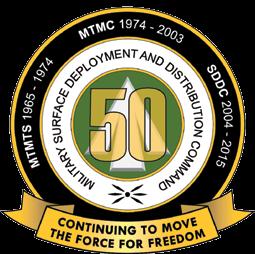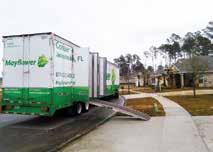
5 minute read
FIFTY YEARS OF MOVING MILITARY FAMILIES
Fifty Years of Moving Military Families Improved Performance – Happier Families
By MG Charlie Fletcher, USA (Ret.)
The Department of Defense (DOD) Personal Property Program is a steady $2.2 billion annual government spend that directly impacts the quality of life for our service members, DOD civilians, and their families. It is really stressful for any family to uproot from their home, move all of their personal possessions, and reestablish new homes. In fact, moving is a top stressor right behind the loss of a spouse and divorce. The Department’s quest to improve the overall household goods move process for moving military families has spanned 50 years and continues to evolve.
In 1965, management of DOD household goods movements was consolidated under the Army’s Military Traffic Management and Terminal Service (the forerunner to today’s Military Surface Deployment and Distribution Command [SDDC]). The command’s task was to improve service by standardizing procedures, consolidating movement information, and ensuring carrier performance. Among its first challenges was developing and integrating 15 automated systems at a time before the advent of personal computers and sophisticated data management systems. The automation path was arduous, time consuming, and was often speared by budget constraints and higher priorities. Despite the challenges, leaders stayed the course and I think most readers will agree the long, enduring journey is paying dividends now.
My own experience in military moves started as the infant son of a career Army Officer moving to Germany (don’t remember much) and progressed
The US Army’s Military Surface Deployment and Distribution Command, headquartered at Scott AFB, Illinois, is celebrating its 50th anniversary as an Army command this year. Officially established on February 15, 1965 as the Military Traffic Management and Terminal Service (MTMTS), the command was redesignated in 1974 as the Military Traffic Management Command (MTMC) to highlight its primary traffic management mission. Thirty years later, in 2004, the organization received its current designation as the Military Surface Deployment and Distribution Command (SDDC) to more directly reflect its global deployment and distribution mission. SDDC is the Army Service Component Command to the US Transportation Command and a Major Subordinate Command of the US Army Materiel Command. SDDC’s mission is to provide global deployment and distribution capabilities to meet our nation’s objectives. By employing a globally postured, professional workforce, SDDC is the preferred choice for deployment and distribution solutions.
SDDC has perpetually evolved throughout the years, to develop innovative deployment, distribution, sustainment, and redeployment logistics and transportation solutions.
With approximately 2,400 people, SDDC books, ships, tracks, and conducts port operations for surface movements, both domestically and worldwide, by leveraging services from the best of the US transportation industry. SDDC also supports Service members, federal employees, and their families with safe and secure delivery of their household goods and privately owned vehicles.
The command manages an average of about 520,000 household goods shipments per year with almost half of those moves occurring between the peak months of May and August. Additionally, SDDC’s Transportation Engineering Agency, also located at Scott AFB, provides the DOD with engineering, policy guidance, research, and analytical expertise, ensuring US military forces can respond successfully to any requirement anywhere in the world.
“From the command’s activation in 1965 through today, SDDC has experienced numer ous changes,” said Major General Susan A. Davidson, Commanding General for SDDC. “Its organizational structure and mission have evolved; its headquarters and units have made numerous relocations; and the command has changed its name, from MTMTS to MTMC to SDDC. But, throughout each of the past 50 years, one thing has remained constant— SDDC’s dedicated support to the Warfighter.”
JUNE 2015 33 moves later to my retirement move after 40 years in uniform. As an Army Captain, I was flying helicopters and thought I needed a break to a less stressful occupation. I took the job as the Army representative to the Joint Personal Property Shipping Office in Hawaii. I certainly did not find any less stress. My phone rang constantly and no one called to say how well things were going. I got calls from families, moving companies, and government offices. “A mover just dropped my family heirloom.” “They aren’t wrapping each plate in a separate box.” “Why don’t I have as many packers as the Admiral down the block?” There were highs and lows, and every day was a new adventure. I remember one day a storage unit manager called me to inspect a crate in the warehouse that was leaking an unidentified liquid. The crate belonged to a young military couple who could not afford to rent an apartment in Hawaii and were awaiting assignment to government housing. The couple were both farm kids who had never been outside the Midwest. They packed their few worldly possessions and sent them to paradise. In the meantime, their departure was delayed and then they had to wait for housing upon arrival in Hawaii. I went to the storage site and opened the container. Inside were two hundred pounds of potatoes undergoing advanced fermentation in 90 degree heat. Apparently, the young couple was told that people in Hawaii ate poi—they figured that meant they needed to bring their own potatoes and snuck them into their shipment. I think anyone working in household goods has

these kinds of stories. The experience of working in a Joint Personal Property Shipping Office proved more than valuable as I would later command SDDC and have direct oversight for the DOD’s Personal Property Program.
By all accounts, today’s Defense Personal Property Program (DP3) has greatly modernized and improved the overall move experience. The Defense Personal Property System (DPS) supports the move process and provides government

Traffic Managers, customers, and Transportation Service Providers (TSPs) with a common web-based platform to manage, communicate, and execute moves. Customers have an opportunity to evaluate and provide a numerical score for their shipment through the program’s formalized Customer Satisfaction Survey. Transportation Service Providers are held accountable for their service through this process and future traffic awards are determined by their overall score and rates which makes up the concept of “Best Value” traffic awards. Other DP3 enhancements include, full replacement value for loss and damaged




